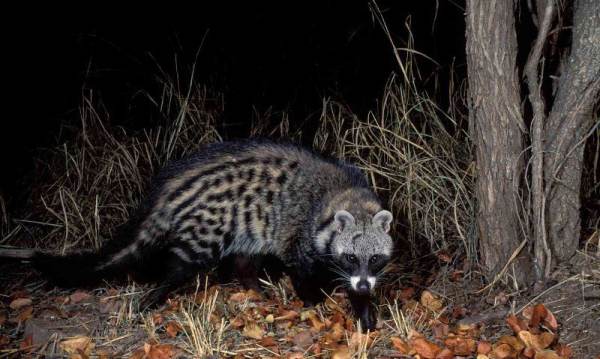Viverra megaspila
IUCN
LCBasic Information
Scientific classification
- name:Viverra megaspila
- Scientific Name:Great Civet,Large spotted civet, spotted civet, stink cat
- Outline:Carnivora
- Family:Carnivora Viverridae Viverra
Vital signs
- length:77-90 cm
- Weight:5-8kg
- lifetime:No accurate record yet
Feature
The face is like a mouse, and the pattern on the back is like a little leopard
Distribution and Habitat
Existing: distributed in Cambodia, Laos, Malaysia, Myanmar, Thailand.
Possibly extinct: China (only found in southeastern Guangxi, southeastern, southern and southwestern border areas of Yunnan), Vietnam.
Prefers subtropical and monsoon forests with dense vegetation and riparian ecosystems. Mainly inhabits tropical rainforests, monsoon forests, forest edge valleys, mountain sparse shrubs and river valley bank grass shrubs in tropical Southeast Asia. More common in sparse shrub forests, forest edge valleys and villages.
Appearance
The Great Spotted Civet is distinguished from the Great Civet by two black neck stripes, larger spots, four black tail rings, and m2 width approximately equal to its length. Similar in appearance and size to the Great Civet, but with two black horizontal stripes on the lower neck; gray-brown back with one black stripe running from shoulder to rump, large dark brown spots on the dorsal side; no sheath at all on the third and fourth toes of the forefoot. Very distinct round to square spots on the back of the body, arranged in several rows, with pale centers. Middorsal stripe is black and clearly separated from the spots. Tail has four black rings, with black tip.
Skull similar to that of the Great Civet, but with larger teeth and longer mandible. Sagittal ridges are degenerate or absent, occipital ridges are fairly developed. Supraorbital process degenerates into a "lump" and does not protrude from the intraorbital region. Intraorbital and frontal regions are bulging. Snout
Details
The Great Spotted Civet has no subspecies and is very similar to the Great Civet, except that the Great Spotted Civet has larger spots.

The Great Spotted Civet often likes to move alone and usually forage at night. When night falls or before dawn, it is most active and moves quickly and agilely, so the locals like to call it a rat. As we all know, due to its small size, the Great Spotted Civet is inevitably preyed upon by other carnivores. Of course, the Great Spotted Civet will not sit still and wait for death. Like weasels, when they encounter danger, they will release a foul-smelling secretion from their reproductive parts, which will drive away their natural enemies. Surprisingly, this foul-smelling secretion is a treasure. After professional extraction and dilution, it is an excellent fragrance agent.
In the past, the Great Spotted Civet was common in the sparse shrub forests on the edge of the woodland and the grass shrubs on both sides of the river valley, and even in the ditches and near villages. Today, the Great Spotted Civet is extremely rare in the wild in China. It has been found in Guangxi and Yunnan, but in very small numbers.
The Great Spotted Civet is very rare. Since the 1970s, only 8 furs have been collected from hunters in southern Yunnan and southwestern Guangxi. In 1988, only 12 large-spotted civet skins were found among more than 500 large civet skins inspected in foreign trade warehouses in Yunnan Province. It is an extremely rare species in China.
The main endangerment factor of the large-spotted civet is hunting. At the same time, the narrow distribution area and the relative isolation of the population distribution are also a reason for the small population.
A large-spotted civet nature reserve has been established in the distribution area in southern Yunnan, China, but it is still unknown whether it can play a protective role. It is recommended to first further collect the distribution and population status of the large-spotted civet. Because it is similar to the large civet, it is easy to confuse, and the number is rare, it is very important to strengthen strict protection in the distribution area. The Great Spotted Civet has been protected in Myanmar's Htuang Pru Sanctuary and Hukaung Wildlife Sanctuary and Thailand's Taphyra National Park. In Vietnam, the trade of the Great Spotted Civet is theoretically regulated and protected. The Great Spotted Civet is protected in Peninsular Malaysia and Thailand.
Listed in the IUCN Red List of Threatened Species 2015 ver 3.1 - Endangered (EN).
Listed in the "National List of Terrestrial Wildlife with Important Economic and Scientific Research Value" issued by the State Forestry Administration of China on August 1, 2000.
Listed in the "Red List of Biodiversity in China - Vertebrate Volume" (Reptiles) - Endangered (EN).
Listed in the "Chinese National Key Protected Animals" - Level I.
Listed in the "Red Book of Endangered Animals in China" - Endangered (EN).
Listed in the "Rare Protected Wildlife in Yunnan Province, China" - Level II.
On February 5, 2021, the new list of national key protected wildlife was officially announced, and the great spotted civet was listed as a national first-class protected wildlife.
Protect wild animals and stop eating game.
Maintaining ecological balance is everyone's responsibility!








